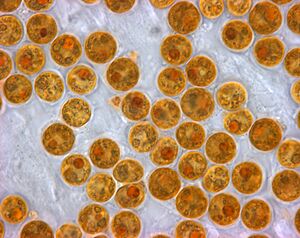Zooxanthellae facts for kids
Zooxanthellae (say "zoh-oh-zan-THEL-ee") are tiny, single-celled living things. They are a type of dinoflagellate, which is a kind of algae. These amazing little cells can live inside other sea animals, like corals, jellyfish, and even some sea slugs (called nudibranchs). This special way of living together is called symbiosis.
Most zooxanthellae belong to a group called Symbiodinium. The name "zooxanthella" means "little yellow animal." It was first used in 1881 by a scientist named Karl Brandt. There are also other tiny green algae called zoochlorellae that live in a similar way in both fresh and salt water.
Contents
What Are Zooxanthellae?
Zooxanthellae are like tiny power plants for the animals they live in. They are photosynthetic, which means they can make their own food using sunlight, just like plants do.
How Do Zooxanthellae Make Food?
These tiny cells have special colors inside them, like chlorophyll a and chlorophyll c. They also have other pigments that make them look yellowish or brownish. This is why many corals and other animals that host them have these colors.
During the day, when the sun is shining, zooxanthellae use sunlight to make sugary foods. They share these foods with the animals they live inside. In fact, they can provide up to 90% of the energy an animal needs to grow, move, and reproduce!
What Do Zooxanthellae Get in Return?
Living inside another animal is a great deal for zooxanthellae too!
- They get a safe place to live.
- They receive important nutrients from the animal's waste.
- They get carbon dioxide, which they need for photosynthesis.
- They often live in a good spot where they can get lots of sunlight.
This partnership is a perfect example of mutualism, where both living things help each other to survive and thrive.
Why Are Zooxanthellae Important?
Zooxanthellae are super important for the health of coral reefs. Corals are animals, but they rely heavily on their zooxanthellae partners to build their hard skeletons and create the amazing structures of reefs. Without healthy zooxanthellae, corals cannot get enough food and can become stressed.
What Happens When Zooxanthellae Leave?
If the ocean water gets too warm or polluted, corals can get stressed. When this happens, they might push out their zooxanthellae. This is called coral bleaching because the coral loses its colorful algae and turns white. If the zooxanthellae don't come back, the coral can die. This is a big problem for coral reefs around the world.


